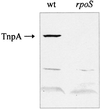Involvement of sigma(S) in starvation-induced transposition of Pseudomonas putida transposon Tn4652
- PMID: 11514532
- PMCID: PMC95431
- DOI: 10.1128/JB.183.18.5445-5448.2001
Involvement of sigma(S) in starvation-induced transposition of Pseudomonas putida transposon Tn4652
Abstract
Transpositional activity of mobile elements can be induced by different environmental stresses. Here, we present evidence that transposition of Tn4652 is elevated in stationary-phase Pseudomonas putida and suppressed in an isogenic sigma(S)-defective strain. We demonstrate that transcription from the Tn4652 transposase promoter is controlled by the stationary-phase-specific sigma factor sigma(S). To our knowledge, this is the first example of direct stationary-phase-specific regulation of a mobile element transposase. Data presented in this report support the idea that activation of transposition under stressful conditions could be an inducible process.
Figures



Similar articles
-
IHF is the limiting host factor in transposition of Pseudomonas putida transposon Tn4652 in stationary phase.Mol Microbiol. 2004 Mar;51(6):1773-85. doi: 10.1111/j.1365-2958.2003.03948.x. Mol Microbiol. 2004. PMID: 15009901
-
Fis negatively affects binding of Tn4652 transposase by out-competing IHF from the left end of Tn4652.Microbiology (Reading). 2009 Apr;155(Pt 4):1203-1214. doi: 10.1099/mic.0.022830-0. Microbiology (Reading). 2009. PMID: 19332822
-
Effects of combination of different -10 hexamers and downstream sequences on stationary-phase-specific sigma factor sigma(S)-dependent transcription in Pseudomonas putida.J Bacteriol. 2000 Dec;182(23):6707-13. doi: 10.1128/JB.182.23.6707-6713.2000. J Bacteriol. 2000. PMID: 11073916 Free PMC article.
-
sigmaS, a major player in the response to environmental stresses in Escherichia coli: role, regulation and mechanisms of promoter recognition.Environ Microbiol Rep. 2014 Feb;6(1):1-13. doi: 10.1111/1758-2229.12112. Epub 2013 Oct 21. Environ Microbiol Rep. 2014. PMID: 24596257 Review.
-
First structural insights into CRISPR-Cas-guided DNA transposition.Cell Res. 2020 Mar;30(3):193-194. doi: 10.1038/s41422-020-0284-y. Cell Res. 2020. PMID: 32127692 Free PMC article. Review. No abstract available.
Cited by
-
Impact of a stress-inducible switch to mutagenic repair of DNA breaks on mutation in Escherichia coli.Proc Natl Acad Sci U S A. 2011 Aug 16;108(33):13659-64. doi: 10.1073/pnas.1104681108. Epub 2011 Aug 1. Proc Natl Acad Sci U S A. 2011. PMID: 21808005 Free PMC article.
-
The ColRS two-component system regulates membrane functions and protects Pseudomonas putida against phenol.J Bacteriol. 2006 Dec;188(23):8109-17. doi: 10.1128/JB.01262-06. Epub 2006 Sep 29. J Bacteriol. 2006. PMID: 17012397 Free PMC article.
-
Pseudomonas 2.0: genetic upgrading of P. putida KT2440 as an enhanced host for heterologous gene expression.Microb Cell Fact. 2014 Nov 11;13:159. doi: 10.1186/s12934-014-0159-3. Microb Cell Fact. 2014. PMID: 25384394 Free PMC article.
-
Cellular variability of RpoS expression underlies subpopulation activation of an integrative and conjugative element.PLoS Genet. 2012;8(7):e1002818. doi: 10.1371/journal.pgen.1002818. Epub 2012 Jul 12. PLoS Genet. 2012. PMID: 22807690 Free PMC article.
-
Site-specific recombination system encoded by toluene catabolic transposon Tn4651.J Bacteriol. 2002 Sep;184(17):4757-66. doi: 10.1128/JB.184.17.4757-4766.2002. J Bacteriol. 2002. PMID: 12169600 Free PMC article.
References
-
- Aviv M, Giladi H, Schreiber G, Oppenheim A B, Glaser G. Expression of the genes coding for the Escherichia coli integration host factor are controlled by growth phase, rpoS, ppGpp and by autoregulation. Mol Microbiol. 1994;14:1021–1031. - PubMed
-
- Bagdasarian M M, Amann E, Lurz R, Ruckert B, Bagdasarian M. Activity of the hybrid trp-lac (tac) promoter of Escherichia coli in Pseudomonas putida. Construction of broad-host-range, controlled-expression vectors. Gene. 1983;26:273–282. - PubMed
-
- Bayley S A, Duggleby C J, Worsey M J, Williams P A, Hardy K G, Broda P. Two modes of loss of the Tol function from Pseudomonas putida mt-2. Mol Gen Genet. 1977;154:203–204. - PubMed
-
- Capy P, Gasperi G, Biemont C, Bazin C. Stress and transposable elements: co-evolution or useful parasites? Heredity. 2000;85:101–106. - PubMed
-
- Chao L, Vargas C, Spear B B, Cox E C. Transposable elements as mutator genes in evolution. Nature. 1983;303:633–635. - PubMed
Publication types
MeSH terms
Substances
LinkOut - more resources
Full Text Sources
Molecular Biology Databases

